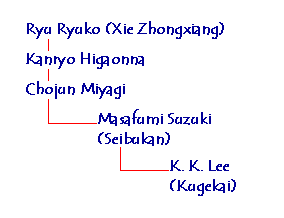|
History
THE RELATIONSHIP BETWEEN CHINESE
FIST ART
AND OKINAWA ANCIENT FIST ART (TANG HAND)
Oriental self-defense art has a very long history, it is
also known as martial arts. Its goal is to preserve health and
discipline, to push the practitioner's potential to the highest level
Chinese martial arts have more than a thousand years of
history. There isn't an agreed say about where this ancient art
originated. It is believed that one of the empty hand fighting fist-art
was introduced into China from India during the sixth century.
About 519DC, the founder of Zen Buddhism, Bodhi Dharma,
traveled to North China from South India to introduce Buddhism. The
Lord of the North China was not fond of Bodhi Dharma's preaching,
therefore Bodhi Dharma crossed the Yang Tze River and settled down in
the Shao Lin Temple where he undertook the form of meditation known as
"nine years facing the wall". The unique breathing of such a kind of
meditation and the art of the preservation of health which he taught his
disciples laid the foundation to the Shao Lin Temple's martial art, and
thus had a marked influence on Chinese theories of fighting methods.
Most of the Shao Lin fist art at that time was created by
imitating the shapes and movement of the animals such as the
dragon-shape, tiger-shape and jaguar-shape...
In 1609 the Chinese fist-art was introduced to Okinawa
from Fu-Jian. At that time, the Japanese martial art masters usually
named their schools by the name of the city where they lived, such as:
Tomari Te (泊
手),
Shuri Te (首里手),
and
Naha Te (那霸手).
They were all called as Tang Hand or Chinese Hand
(唐手)
in general.
The powerful lord, Satsuma of Japan banned all the
military class and confiscated all arms in order to ensure his power and
control. For this reason the combative techniques of Okinawa, which
have been handed down to the present day, use only the stick, the club,
and the empty hand (karate).
In ancient times, the martial art masters had very strict
rules to recognize their students. Only a person of sterling and noble
character would be accepted as their student. For this reason a lot of
precious martial art techniques are now extinct because of a lack of
suitable students.
 back
to the top back
to the top
THE STYLE
The style ofkarate that we practice is Okinawa Gojuryu. Miyagi
Chojun Sensei is the individual who originated this martial art on the island
of Okinawa in Japan.
Directly translated, Gojuryu is known as the hard-soft style. Go,
meaning hard; ju meaning soft; and ryu meaning style.
 back
to the top back
to the top
THE MEANING OF KUGEKAI
Ku means bridge. A bridge serves as a connector between two different
places and allows people who are committed towards a common goal to come
together. The bridge serves its role regardless of harsh weather and
adverse conditions. Bridge, therefore, symbolizes the spirit of
Karate: perseverance and endurance of hardship.
Ge means governing. All the members work together to govern/manage the
association.
Kai means an association.
Kugekai, therefore, symbolizes a spirit which unifies and motivates
people who have a common goal in Karate to manage the association with
courage, faith and perseverance.
 back
to the top back
to the top
LINEAGE

 back
to the top back
to the top
|